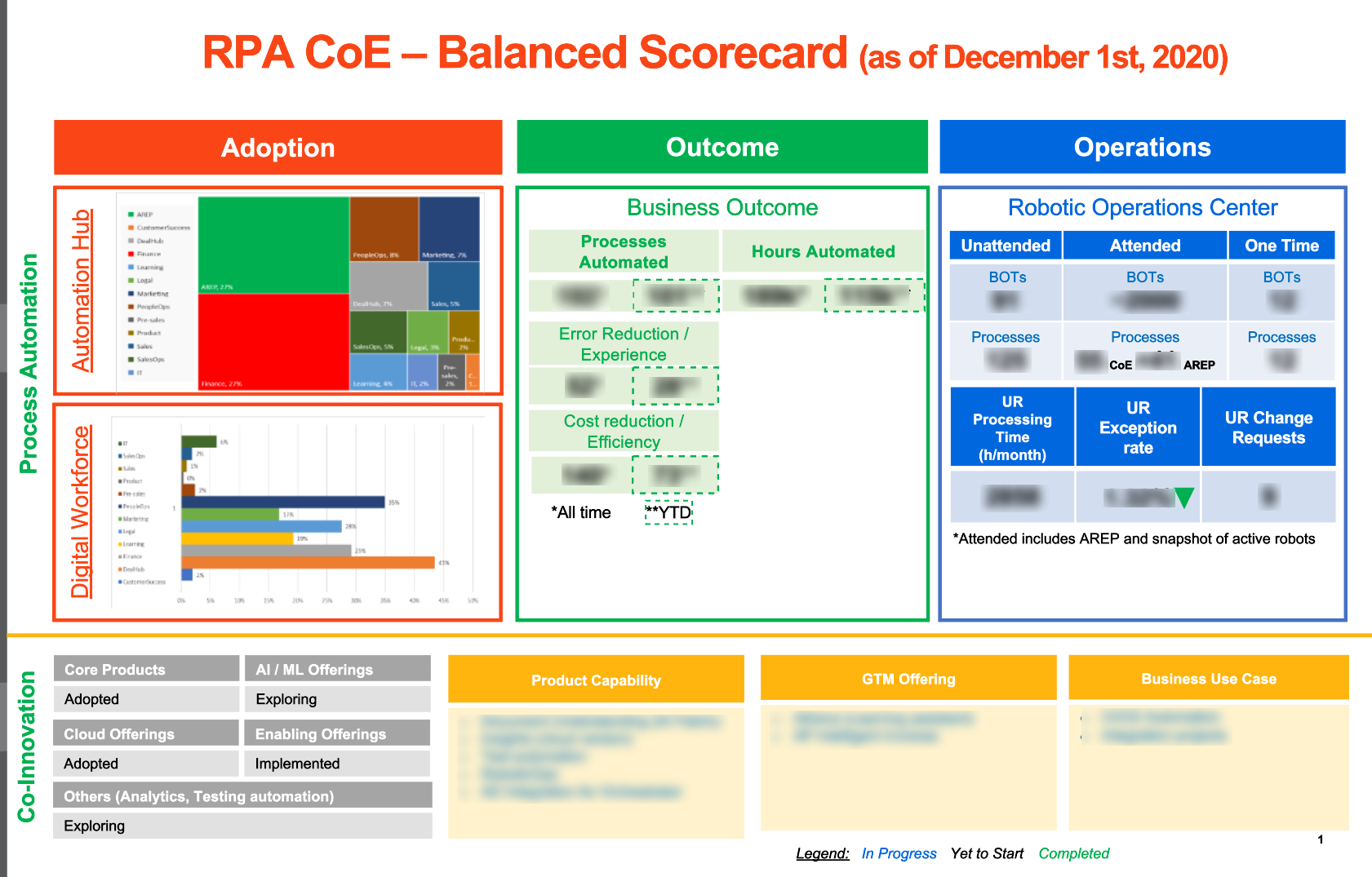How to Evangelize RPA Within Your Organization
Share at:

No matter how clear the business benefits of robotic process automation (RPA) technology may be, the deployment approach—"How do we roll it out?"—may be a challenging new concept for many companies. While many organizations have a successful track record implementing enterprise technologies, an RPA project demands knowledge of existing processes and how employees perform their jobs.
As a result, many companies may wonder what they should do to implement their first RPA program and how to communicate its benefits. Others may have achieved success with their RPA pilot but struggle when it comes to rolling it out to other departments in the organization. Such uncertainty is understandable, especially considering that this part of the RPA experience is relatively new.
Yet one best practice has emerged.
To successfully deploy the RPA program—and reap as many benefits as possible across the entire organization—companies need a well-defined RPA communications and advocacy plan consisting of three important touch points:
Complete awareness, buy in, and support from senior leadership.
Grassroots-level advocacy from line of business (LOB) managers and key employees in departments most affected by the automation project.
Comprehensive, proactive communication plans, complete with tangible marketing assets, to give employees the information they need, every step of the way.
The right strategy is critical
Developing such a comprehensive plan is critical to the success of any RPA project, yet many companies do not know how to create them.
While there is no silver bullet approach to creating the winning strategy, it is clear that a successful strategy must do all it can to articulate the many benefits for RPA to employees at every level of the organization. “Telling the whole story” is vital in clearing up common misconceptions about RPA and alleviating employees’ concerns that robots could be coming for their jobs.
Proactive communication will also convert skeptical employees into project advocates, willing and able to play a visible role in the deployment process.
The link between employee engagement and RPA success
In working with UiPath customers, we have identified a clear and irrefutable correlation between internal communication strategies and the overall success of an RPA project. Specifically, those companies that develop and execute an effective change management plan see much better results than those that don’t.
It’s really not that surprising, considering that this is a critical step in communicating the benefits of RPA and easing employees’ concerns. Most workers simply don’t know a lot about RPA yet, which can lead to the common misconception that this technology is coming to take their jobs.
At a minimum, misinformed employees may distrust RPA and adopt a defensive “wait and see” mindset. At worst, they may actively oppose the project and even rally others to this position. Both of which can significantly disrupt the entire implementation process. Either stance will contribute to the RPA rollout failing to reach its full potential. And could put it at risk of lower-than-expected adoption rates and use, a sluggish ROI, and resistance from other departments in the organization.
Companies that see these challenges as opportunities stand to gain the most. For example, developing a comprehensive internal communication plan will go a long way to educating and reassuring employees, soliciting feedback, and engaging them as a vital part of the implementation. It’s important to note that employee engagement is not just a “would-be-nice-to-have” metric on HR’s wish list. Research has proven that companies with highly engaged employees experience 22% greater productivity than those that do not.
Where should companies start to develop the right strategy?
First, carefully consider stakeholder groups throughout the entire organization and focus on three specific groups:
Senior management. Support from executives is critical to the success of any RPA project and must occur at every step—from proof of concept to large-scale deployment. But, in the early phases, senior management may not even know what RPA is, never mind how it will benefit the organization. An effective RPA deployment strategy must plan to brief executives, give them access to additional marketing pieces, and provide regular reporting to demonstrate progress and highlight results.
LOB managers. These managers represent important middle ground since they have business unit responsibility but also maintain productive relationships with direct reports and other employees. Helping them understand exactly what RPA will and will not do—for example, it will automate low-value tasks, but it won’t threaten employees’ jobs—is a crucial first step in creating a valuable project ally.
Employees. It is vital to proactively communicate with employees. For example, let them know what RPA is, what processes are a natural fit for automation, and how this technology will free them to focus on higher-value, more rewarding work. Companies should provide as much education, information, and ongoing training as possible, while also periodically checking in to answer questions they may have. All of this sends the message that the company understands their concerns and is fully committed to doing all it can to alleviate them.

Above all else, the organization should do all it can to make sure everyone feels respected and valued by providing complete transparency, updates, and truth.
The right principles shape the right approach
After thinking through various employee segments, the RPA team should carefully consider a number of principles and communication and engagement best practices that are specific to an RPA deployment.
Senior champions and project sponsors should be highly visible during the entire project, including public evidence of their support. Their ongoing commitment to the project’s success will help build and maintain momentum and rally early skeptics to the cause.
The RPA team needs to carefully consider overall timing and various dependencies, especially considering that some activities simply can’t be completed before others. For example, if an RPA project was driven by management, the RPA team should work with them to develop a clear message before attempting to hold company-wide awareness sessions.
The team’s RPA messages must be as clear as possible. For example, employee-facing messages should contain easily understood goals as well as specific details for how the entire company will achieve them.
The RPA team should identify employees who will be affected (e.g., those who will be turning their tasks over to software robots) as quickly as possible and clearly communicate what will happen next. This is a critical step to connecting with employees who could otherwise become disengaged, garnering their support, and making sure they’re fully invested in the project.
The RPA team should also be very honest about any setbacks or 'bumps in the road' that may happen along the way. The team should reiterate its original intent, describe lessons learned, address specific concerns, and highlight any new plans to make sure the RPA project is back on track.
Some of the best automation ideas come from the bottom up, from the business users who are closest to the problems and best positioned to identify solutions. That is why the RPA team should actively seek internal automation champions to help identify new automation ideas. Using the right tools, such as UiPath Automation Hub, to source, assess, and qualify automation ideas will fuel a positive feedback loop and accelerate adoption.
Finally, the entire company should go out its way to celebrate every success—even for the smallest milestone achievement—and share all good news throughout the entire organization.
UiPath Vice President of Product Marketing Diego Lomanto explains more about how automation ideas fuel the feedback loop and accelerate adoption:

Elements of an effective advocacy and communication plan
There are many different elements that could—and should—go into a communication plan to help the entire automation deployment be more successful.
Proactive, ongoing communications: RPA teams should plan to communicate with the entire company as regularly as possible. This can be done using email or a newsletter and should look to promote success stories, recognize valuable team members, share employee stories, and highlight positive results.
A dedicated portal: An internal web portal can be an effective tool of evangelization, create RPA “buzz,” contain articles and use cases, and give management performance dashboards. However, a portal implementation can also risk distracting the team from its automation mission.
Personas: Companies should also develop specific persona for various audience segments, such as senior management, business unit managers, employees, and more. These personas are instrumental to identify with each group’s interests and motivations and can be used to develop more effective communications.
Stakeholder meetings: Project sponsors should host regular meetings where key stakeholders can raise a concern, contribute to the process, identify areas for improvement, or even just learn more about progress to date.
Webinars and videos: Webinars and videos are extremely effective in communicating key details about the RPA project, including its benefits, the rollout plan, use case successes, how employees can get started, and more.
Questionnaires: The RPA team should also measure the overall effectiveness of their efforts by periodically checking in with employees. Questionnaires and surveys are great tools to see if the RPA deployment is meeting users’ expectations or what the RPA team can do to improve.
Training and e-learning: HR and training departments should also provide thorough training programs and e-learning modules to give employees access to educational tools to learn more about an upcoming RPA project. Find out how to create a training strategy.
Internal users’ clubs: Users’ clubs are an excellent opportunity to connect with employees who may be interested in launching an RPA project of their own and facilitate deeper discussions. Club meetings can demonstrate what other departments are doing with RPA, highlight lessons learned, or give these employees a sense for what they can expect from their own projects.
Milestone celebrations: Many organizations celebrate important milestones, such as the successful deployment of the first robot. These celebrations rally employees around a common cause and encourage future support and participation.
Here's an example of one of the ways we communicate automation successes to UiPath employees. It's a robot scorecard!

Plan today, succeed tomorrow
With so much to offer, RPA should be the rare win-win in the business world: proven technology that benefits employees and the organization. Yet if companies don’t develop the right advocacy plan—one that communicates the benefits of RPA and engages all employees in the process—they may struggle to achieve its full potential.
To overcome this potential issue, companies need to carefully plan and execute their advocacy and communication plan. No matter if they’re just starting their automation journey, or if they’ve successfully completed their initial pilot program, these companies should invest time and resources in developing a comprehensive advocacy and communication plan.
Thinking through the right approach and making sure employees get what they need—each step of the way—can help any organization capitalize on all that RPA has to offer.
Already a UiPath customer? Be sure to check out the resources available to you in the UiPath Customer Portal and via the Unified Customer Success Program.

Director Program Management, Customer Success, UiPath
Get articles from automation experts in your inbox
SubscribeGet articles from automation experts in your inbox
Sign up today and we'll email you the newest articles every week.
Thank you for subscribing!
Thank you for subscribing! Each week, we'll send the best automation blog posts straight to your inbox.



